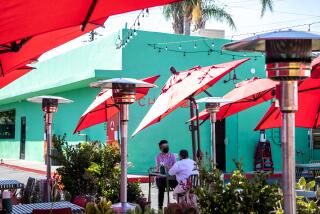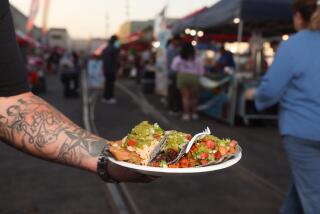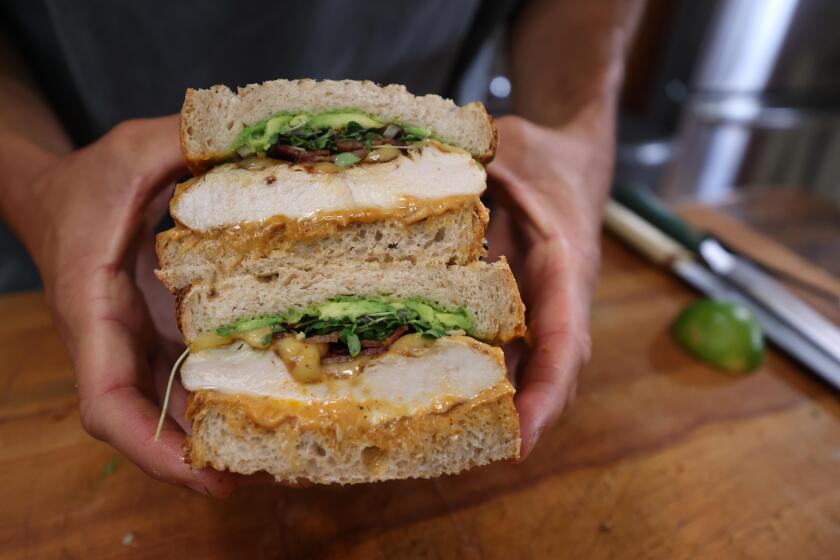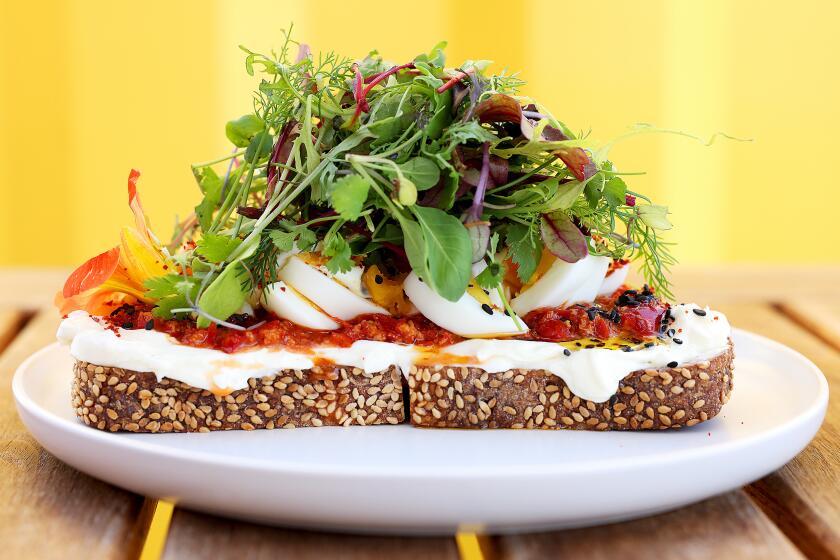Street food is legal, but vendors could still be squeezed as new rules are worked out

Ten years ago, there were few better places in Los Angeles to eat Mexican street food than a city parking lot just off the corner of Breed Street and Cesar Chavez in Boyle Heights. Every night, vendors served a panoply of grilled, fried and stuffed masa: Mexico City-style quesadillas lined with squash blossom and cheese, tacos al vapor filled with jiggly bits of steamed cow, or crunchy huaraches topped with mounds of carnitas and laced with salsa and crema.
Breed Street, as the informal (and unpermitted) market was often called, existed in one form or another for the better part of a decade, gaining notice from local papers and food blogs. But in 2009, police shut it down for good. Street vending is illegal in Los Angeles, after all. Or at least it was.
What was the loss of a great, affordable dinner destination for some was far more catastrophic for the Breed Street vendors.
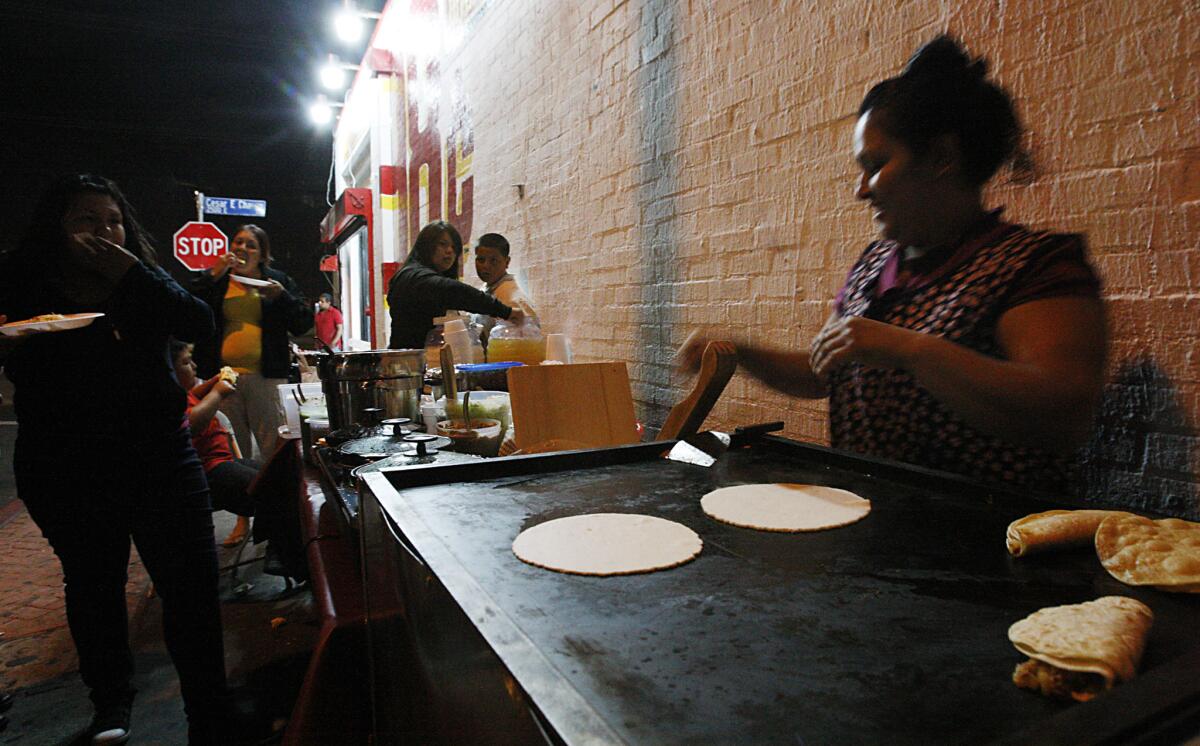
“When it got shut down there, there wasn’t a place to sell,” says Caridad Vazquez, a vendor there for four years. “I needed money, and that was the spot that everybody knew.”
Vendors who had entered the country illegally or overstayed their visas were particularly at risk: Criminal charges stemming from illegal vending could ultimately lead to deportation. After a permitted farmers market featuring some Breed Street regulars failed to take off, a group of vendors turned to the East Los Angeles Community Corp., a local nonprofit focused on development and housing.
“They were the ones who convinced us that this was a land-use issue,” says Carla DePaz, director of community organizing at the nonprofit.
That meeting was the beginning of the Los Angeles Street Vendor Campaign, which, building on at least a decade of work by various organizations — and spurred by concerns over the increased immigration enforcement promised by President Trump — helped push the City Council to decriminalize street vending in Los Angeles in February.
Now, after an 11-4 vote by the council in April, the city attorneys are writing regulations to establish a permitting process that could legitimize L.A.’s 50,000 or so street vendors. Significantly, a proposed amendment that would have given adjacent business owners the right to veto a vending permit failed to pass.
The directive given to the city attorneys by the council includes very strong protections for immigrants. Vendors will be able to use a range of different identifications when applying for a permit — be it a California state ID or a Mexican passport — and will not need a Social Security number. Violations for vendors who are not permitted will be treated as an administrative concern, leading to fines instead of criminal charges.

“There’s an overall feeling in council that we want to support our immigrant population, and we don’t want to funnel anyone into the criminal justice system simply for trying to make a living,” says council member José Huizar, who represents Boyle Heights and other parts of the East Side — where, as he put it, “there’s a largely immigrant, Latino population, and street vending is accepted.”
But the closing of Breed Street is just one example of how, even in a neighborhood like Boyle Heights, vendors were squeezed out under the old system. Organizers also cite instances of extortion at the hands of both business owners and gangs.
If a market like Breed could soon be both an accepted and permitted fixture in a predominantly Latino neighborhood, the same might not be true in wealthier, whiter parts of the city represented by the four council members who voted against the measure: Mike Bonin, Mitchell Englander, Paul Koretz and Bob Blumenfield.
Some areas, such as Staples Center and Hollywood Boulevard, are already designated as no-vending zones in the directive city attorneys are working from. Campaign lawyer Doug Smith says provisions limiting the number of vending permits to two per “face block” — one block, one side of the street — and allowing for special vending districts could be used to keep vendors out of certain neighborhoods.
“The city should be able to regulate and set rules if they’re needed to protect safety and public health,” Smith says, but not because residents or business owners don’t like the aesthetics of street vending. “If you create this system where wealthier neighborhoods can just opt out, it becomes this new form of red-lining.”
Despite the lingering concerns, organizers and vendors are feeling optimistic about the new era of legal street vending in L.A.
“Now that I can street vend legally, I don’t have to worry about the police taking away my equipment or food,” says Vazquez. “I can finally do it comfortably, without having to worry about anything.”
Willy Blackmore is a freelance journalist who covers food, culture and the environment. He’s on twitter @willyblackmore.
More to Read
Eat your way across L.A.
Get our weekly Tasting Notes newsletter for reviews, news and more.
You may occasionally receive promotional content from the Los Angeles Times.

